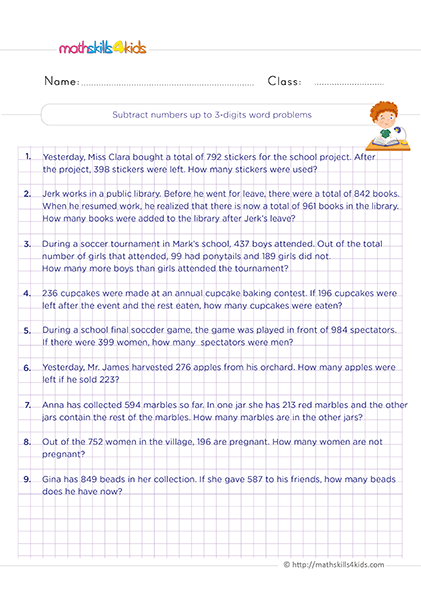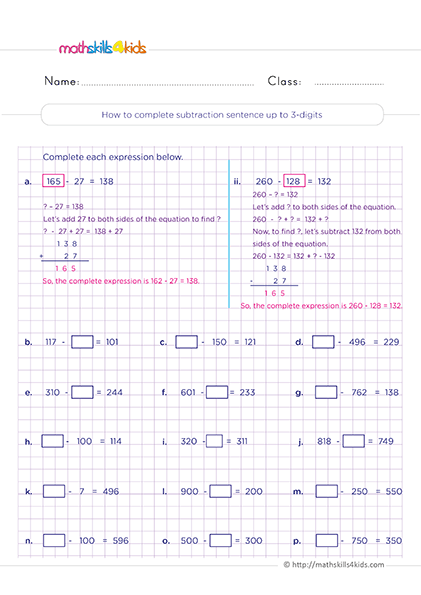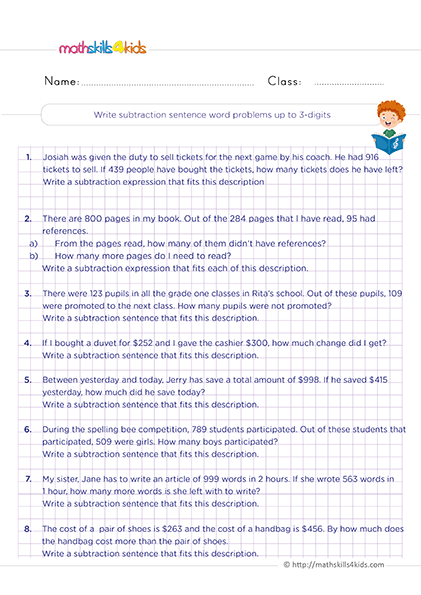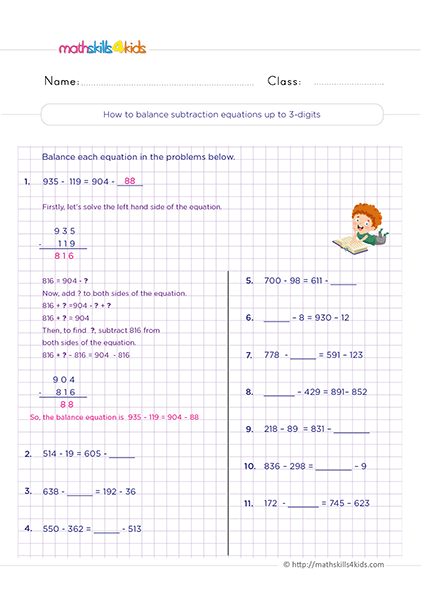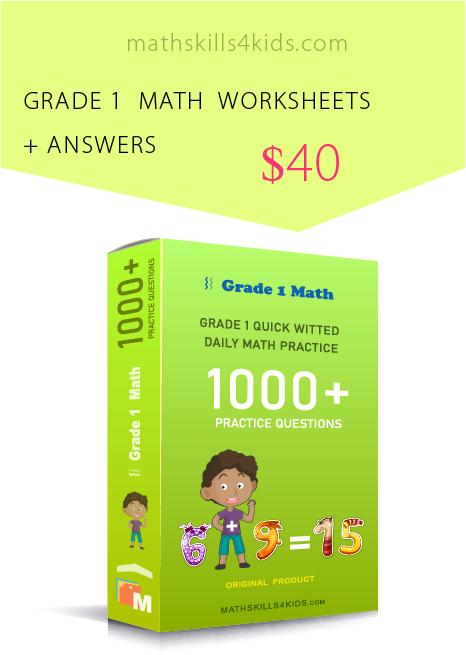Mastering 3-digit subtraction with printable worksheets for 2nd Grade math
Are you looking for a way to help your 2nd grader master 3-digit subtraction? Do you want to make math fun and engaging for your child? If so, you've come to the right place! In this article, we will provide you with some printable worksheets for 2nd-grade math that you can use to practice 3-digit subtraction at home or in the classroom.
In addition, we will show you everything you need to know about 3-digit subtraction, why it's important for 2nd-grade math, and how to teach it using place value and regrouping. We will also share some tips and tricks for making 3-digit subtraction easy and enjoyable for your child.
So let's get started!
-
What is 3-digit subtraction?
3-digit subtraction is the process of taking away a number that has up to 3 digits from another number that has 3 digits. For example, 456 - 78 is a 3-digit subtraction problem.
To solve 3-digit subtraction problems, we can use the standard algorithm, which involves lining up the numbers according to their place values (ones, tens, and hundreds) and subtracting them column by column, starting from the ones.
Sometimes, we may need to regroup or borrow from the next higher place value when the digit on the bottom is larger than the digit on the top. For example;
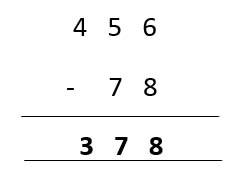 In 456 - 78, we cannot subtract 8 from 6 in the ones column, so we need to borrow a ten from the tens column and add it to the ones column. Then we can subtract 8 from 16 and get 8. We must also subtract one from the tens column to account for the borrowing.
In 456 - 78, we cannot subtract 8 from 6 in the ones column, so we need to borrow a ten from the tens column and add it to the ones column. Then we can subtract 8 from 16 and get 8. We must also subtract one from the tens column to account for the borrowing.
Then we can subtract 7 from 5 and get -2. But we cannot have a negative number in our answer, so we need to borrow a hundred from the hundreds column and add it to the tens column. Then we can subtract 7 from 14 and get 7. We must also subtract one from the hundreds column to account for the borrowing.
Then we can subtract 0 from 3 and get 3.
So our final answer is 378.
-
BROWSE THE WEBSITE
-
DOWNLOAD FREE WORKSHEETS
-
-
2nd GRADE MATH TOPICS
- Counting and numbers
- Comparing and ordering
- Reading and writing numbers
- Shape patterns
- Adding of 1-digit numbers
- Subtracting of 1-digit numbers
- Additing 2-digit numbers
- Subtracting within 2-digits
- Up to 3-digit addition
- Subtracting within 3-digit
- Properties of addition & subtaction
- Mixed operations
- Place-value
- Estimating and rounding
- Logical reasoning
- Money Math
- Telling Time
- Data and graphing
- Units of measurement
- 2D shapes
- 3D shapes
- Geometric measurement
- Fractions
- Probability
- Multiplication
- Division
-
-
-
Why 3-Digit subtraction is important for 2nd Grade Math
3-digit subtraction is important for 2nd-grade math because it helps students develop their number sense, mental math, and problem-solving abilities. It also prepares them for more advanced math topics in later grades, such as fractions, decimals, and algebra.
By learning how to subtract numbers with up to three digits, students can apply their knowledge to real-world situations involving measuring, counting, comparing, estimating, and calculating.
For example, they can use 3-digit subtraction to find out how much change they will get when they buy something at a store, how many miles they have traveled on a road trip, how many minutes they have left until recess, or how many books they can borrow from the library.
-
How to teach 3-digit subtraction using place value and regrouping
One of the best ways to teach 3-digit subtraction is by using place value and regrouping strategies.
Place value is the idea that each digit in a number has a different value depending on its position. For example;
In the number 456, the digit 4 has a value of 400 because it is in the hundreds place, the digit 5 has a value of 50 because it is in the tens place, and the digit 6 has a value of 6 because it is in the ones place.
Regrouping is exchanging one group of units for another group of equal value. For example, we can regroup one hundred into ten tens or ten tens into one hundred. We can also regroup one ten into ten ones or ten ones into one ten.
Using place value and regrouping helps students understand what they do when subtracting numbers with up to three digits. It also helps them avoid common mistakes such as forgetting to borrow or carrying over.
Here are some steps you can follow to teach your child how to subtract numbers with up to three digits using place value and regrouping:
- Review the concept of place value and how each digit in a number has a different value depending on its position.
- Review how to write numbers in expanded form using place value. For example, write 456 as (4 x 100) + (5 x 10) + (6 x 1).
- Review how to regroup numbers using place value. For example, show how one hundred can be regrouped into ten tens or how one ten can be regrouped into ten ones.
- Explain how to subtract numbers with up to three digits using the standard algorithm. Show how to line up the numbers according to their place values and subtract them column by column, starting from the ones.
Demonstrate how to regroup when needed and write the answer in standard form.
- Provide some examples and practice problems for your child to try. Use different types of problems, such as ones that require no regrouping, ones that require regrouping in one place, and ones that require regrouping in two places.
Check their work and give feedback.
- Use manipulatives like base-ten blocks to help your child visualize and model the subtraction process. Show how to use the blocks to represent the numbers and how to regroup them when needed.
Please have your child use the blocks to solve problems and explain their steps.
- Use word problems to help your child apply their subtraction skills to real-world situations. Ask them to read the problem carefully, identify the given information and what they need to find out, write a number sentence, solve it using the standard algorithm, and check their answer.
Have them explain their reasoning and show their work.
-
Tips and tricks for making 3-digit subtraction fun and easy
Here are some tips and tricks you can use to make 3-digit subtraction fun and easy for your child:
- Use games, puzzles, riddles, and jokes to make subtraction more engaging and enjoyable. You can find some online or create your own using printable worksheets for 2nd-grade math.
- Use songs, rhymes, mnemonics, and acronyms to help your child remember the steps and rules of subtraction. For example, you can use the acronym "BUD" (Borrow from the Upper Digit) or the rhyme "More on the floor? Go next door!" to remind them when and how to regroup.
- Use different methods and strategies to help your child solve subtraction problems faster and easier. For example, you can use mental math, estimation, rounding, compatible numbers, or inverse operations (adding instead of subtracting).
- Use different formats and representations to help your child practice subtraction in different ways. For example, you can use number lines, grids, charts, graphs, or pictures to show subtraction visually.
- Use different difficulty levels and challenges to help your child progress at their own pace and build their confidence and skills. For example;
You can start with simple problems that require no regrouping and gradually move on to more complex problems that require regrouping in one or two places.
-
Printable worksheets for 2nd Grade Math: 3-Digit subtraction practice
One of the best ways to practice 3-digit subtraction is by using printable worksheets for 2nd Grade Math. These worksheets are great for reinforcing the concepts learned in class, checking your understanding, and providing extra practice at home or on the go.
In this section, we will share worksheets to practice 3-digit subtraction with different skills and strategies.
- Subtracting multiples of 10 or 100: This worksheet helps your kids practice subtracting multiples of 10 or 100 from 3-digit numbers. For example, 500 - 200 = 300.
To do this, they only need to subtract the digits in the same place value and write the answer below. They don't need to regroup or borrow any digits.
This worksheet has 12 problems to solve.
- Subtracting numbers up to 3-digit word problems: This worksheet helps your child practice subtracting numbers up to 3-digit in word problems.
For example, John has 345 stickers and gives 127 stickers to his friend. How many stickers does John have left?
To do this, read the problem carefully, identify the minuend and the subtrahend, and write a subtraction sentence.
Then, they must subtract the digits from right to left and regroup or borrow if necessary.
This worksheet has 10 problems to solve.
- How to complete subtraction sentences up to 3 digits: This worksheet helps your kids practice completing subtraction sentences up to 3 digits.
For example, ___ - 156 = 189. To do this, they must find the missing minuend by adding the subtrahend and the difference. Then, it would be best to write the answer in the blank space.
They can use a number line or a place value chart to help you.
This worksheet has 15 problems to solve.
- Write subtraction sentences word problems with numbers up to 3 digits: This worksheet helps your 2nd graders practice writing subtraction sentences word problems with numbers up to 3 digits.
For example, Mary has some apples and eats some of them. She has 231 apples left. How many apples did she eat? To do this, they must write a word problem matching the given subtraction sentence.
They can use different names, objects, and situations to make your word problem exciting and realistic.
This worksheet has 10 problems to write.
- How to balance subtraction equations up to 3 digits: This worksheet helps your kids practice balancing subtraction equations up to 3 digits.
For example, 456 - ___ = 345 - ___. To do this, they need to find the missing numbers that equal both sides of the equation.
They can use trial and error or inverse operations to help you.
This worksheet has 12 problems to solve.
Printable worksheets for 2nd-grade math offer a variety of benefits, such as:
- They provide ample practice opportunities for your child to apply their subtraction skills and strategies.
- They allow you to monitor your child's progress and identify their strengths and weaknesses.
- They enable you to customize your child's learning experience according to their needs and preferences.
- They motivate your child to learn by making subtraction fun and rewarding.
- Subtracting multiples of 10 or 100: This worksheet helps your kids practice subtracting multiples of 10 or 100 from 3-digit numbers. For example, 500 - 200 = 300.
-
How to check your answers and avoid common mistakes in 3-digit subtraction
After your kids have solved a 3-digit subtraction problem, you must check their answer and ensure they avoided common mistakes in 3-digit subtraction and did everything correctly.
One way to check an answer is to use estimation. Estimation means finding a close or reasonable answer by rounding the numbers or using compatible numbers. For example, if you want to estimate 576 - 248, you can round both numbers to the nearest hundred and subtract: 600 - 200 = 400.
This tells you that the exact answer should be close to 400. If you get an answer that differs from the estimate, your child might have made a mistake.
Another way to check your learner's answer is to use the inverse operation of subtraction, which is addition. This means adding the difference and the subtrahend to get back the minuend.
For example, if a child has solved 576 - 248 = 328, you can check their answer by adding 328 + 248 and seeing if they got 576.
If they did, then the answer is correct. If not, then there is a need to redo the subtraction.
Common mistakes in 3-digit subtraction and how to avoid it
Some common mistakes that people make when doing 3-digit subtraction are:
- Not lining up the numbers correctly according to their place values. This can cause confusion and errors when subtracting the digits in each column.
Always ensure that the ones are under the ones, the tens are under the tens, and the hundreds are under the hundreds.
- Refrain from regrouping or borrowing correctly when the digit in the subtrahend is larger than the digit in the minuend. This can lead to negative numbers or incorrect differences.
Always remember to take one from the next higher place value and add it to the current digit in the minuend when you need to regroup or borrow.
- Not writing down the regrouped or borrowed number above the minuend. This can make you forget that you have regrouped or borrowed and cause errors in subtraction.
Always write down the number taken from the next higher place value above the minuend to keep track of it.
- Not writing down the difference below the line in each column. This can make you lose track of your answer and keep the same digits.
Always write down the difference below the line in each column as you subtract.
- Not lining up the numbers correctly according to their place values. This can cause confusion and errors when subtracting the digits in each column.
Additional resources for improving your 3-digit subtraction skills
If you want to learn more about 3-digit subtraction and improve your skills, you can use online resources. Here are some examples of online resources that can help you with 3-digit subtraction:
- Videos: You can watch videos that explain how to do 3-digit subtraction with or without regrouping, how to check your answers, and how to avoid common mistakes.
You can also watch videos that show you how to solve different types of 3-digit subtraction problems, such as word problems, subtraction sentences, and balancing equations.
Some examples of websites that have videos on 3-digit subtraction are Khan Academy, Math Antics, and Math is Fun.
- Games: You can play games that test your 3-digit subtraction skills and make learning fun. You can choose games that have different levels of difficulty and different themes.
Some examples of websites that have games on 3-digit subtraction are Math Playground, SplashLearn, and Education.com.
- Quizzes: You can take quizzes that assess your 3-digit subtraction skills and give you feedback on your performance.
You can choose quizzes that have different formats and different types of questions.
Some examples of websites that have quizzes on 3-digit subtraction are IXL, SoftSchools, and K5 Learning.
Thank you for sharing the links of MathSkills4Kids.com with your loved ones. Your choice is greatly appreciated.
In conclusion, remember that 3-digit subtraction is an essential skill for 2nd grade math and beyond. It helps you find the difference between two numbers with up to three digits each.
You can use different methods for 3-digit subtraction, such as regrouping or borrowing, estimation, and inverse operations.
You can also practice your 3-digit subtraction skills using printable worksheets, online videos, games, and quizzes.
By mastering 3-digit subtraction, you can improve your math fluency and problem-solving abilities.
-
